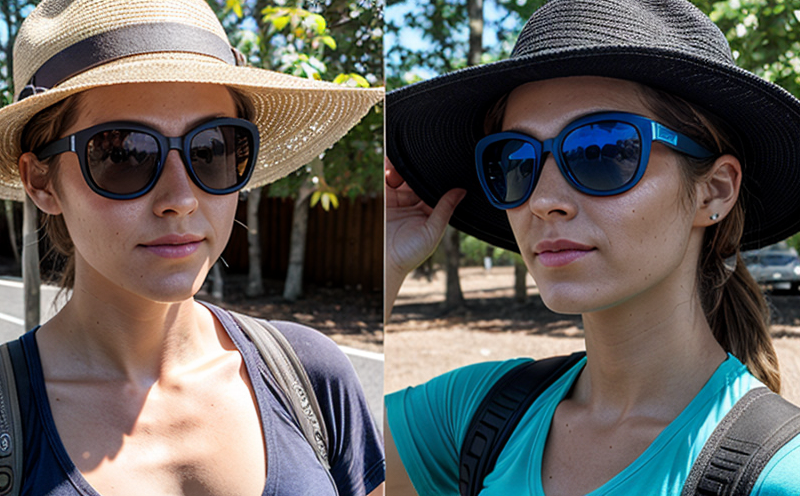GB T 18830 Evaluation of UV protective performance of textiles
The PRC national standard GB/T 18830 specifies the method for evaluating the ultraviolet (UV) protection performance of textiles. This test is essential for ensuring that textile products effectively shield consumers from harmful UV radiation, thereby reducing the risk of skin damage and related health issues.
The evaluation process involves exposing a representative sample to standard UV radiation sources under controlled conditions. The amount of UV light transmitted through or absorbed by the fabric is measured using standardized instruments. The results provide an objective assessment of the fabric's ability to block UV rays, which is critical for products such as clothing, outdoor gear, and window coverings.
The GB/T 18830 method has been widely adopted in China due to its stringent requirements and consistent quality control measures. Compliance with this standard ensures that textile products meet the necessary safety and performance criteria, thereby protecting consumers from potential health risks associated with prolonged UV exposure.
For manufacturers and suppliers, adhering to GB/T 18830 offers several advantages. Firstly, it enhances brand reputation by demonstrating a commitment to consumer safety and well-being. Secondly, compliance can open up new market opportunities in regions that prioritize textile quality and safety standards. Lastly, meeting these requirements can help businesses avoid potential legal issues or recalls associated with non-compliant products.
Understanding the specific parameters involved in this testing process is crucial for manufacturers looking to comply fully with GB/T 18830. The test involves carefully selecting representative samples that accurately reflect the intended product range. Specimen preparation typically includes washing and drying procedures consistent with normal consumer usage, followed by conditioning under specified temperature and humidity conditions.
The actual testing process uses specialized equipment designed to simulate real-world exposure to UV radiation. This may include artificial sun lamps or other similar devices capable of generating wavelengths relevant to natural sunlight. The specimens are then placed in the apparatus according to prescribed protocols, ensuring accurate measurement of both transmitted and blocked UV light.
After completing the test run, detailed measurements are taken using high-precision instruments. These readings are compared against predefined thresholds set out by GB/T 18830, allowing for clear determination of whether the fabric meets the required protection levels. Results are reported in terms of UV protection factor (UPF), which indicates how many times more UV radiation is blocked than would be without the fabric.
Compliance with GB/T 18830 not only ensures product safety but also plays a vital role in maintaining market integrity and fostering trust among consumers. By adhering to these rigorous standards, companies can contribute positively to public health while enhancing their competitive position within the industry.
Why It Matters
The importance of UV protection cannot be overstated given the increasing prevalence of skin cancer and other related illnesses linked to excessive sun exposure. Textiles play a crucial role in mitigating these risks by providing an additional layer of defense between individuals and harmful UV rays.
- Reduces risk of skin damage: By blocking up to 98% of UV radiation, compliant fabrics significantly lower the likelihood of developing conditions like sunburns or more severe forms of dermatitis.
- Promotes healthier lifestyles: Consumers can feel reassured knowing they are protected from harmful UV rays when engaging in outdoor activities such as hiking, gardening, or beach trips.
- Supports sustainable practices: Promoting the use of high-UPF textiles helps reduce reliance on sunscreens and other chemical-based solutions, contributing to a greener approach to personal protection.
The implementation of GB/T 18830 ensures that textile products meet stringent performance criteria, further enhancing their effectiveness in protecting users from UV radiation. This standardization contributes to broader societal benefits by promoting healthier living habits and supporting sustainable environmental practices.
Why Choose This Test
- The GB/T 18830 test provides an objective measure of a textile's ability to block UV radiation, ensuring consistent quality across different products.
- It helps manufacturers comply with national and international safety regulations, thereby protecting their reputation and avoiding potential legal issues.
- The standardized testing procedure ensures that all samples are exposed to identical conditions, leading to reliable and reproducible results.
- Compliance with this standard can open up new market opportunities in regions where textile quality is highly valued.
- GB/T 18830 offers clear guidelines for specimen preparation, making it easier for laboratories to perform tests accurately and consistently.
- The test results are widely recognized within the industry, enhancing confidence among consumers regarding product safety and effectiveness.
By choosing this evaluation method, companies can demonstrate their commitment to consumer safety and well-being while maintaining a competitive edge in the marketplace. The rigorous nature of GB/T 18830 ensures that textile products meet or exceed necessary protection levels, providing peace of mind for both producers and consumers alike.
Quality and Reliability Assurance
The quality and reliability assurance aspects of the GB/T 18830 test are critical to ensuring consistent performance across all batches of textiles. Regular calibration of testing equipment, strict adherence to specimen preparation protocols, and continuous training for personnel involved in conducting tests help maintain high standards.
- Regular recalibration: Ensuring that all instruments used in the test remain accurate over time through periodic recalibrations.
- Specimen preparation consistency: Strict guidelines are provided for preparing specimens according to prescribed washing and drying methods, followed by conditioning under specified environmental conditions.
- Personnel training: Continuous professional development programs ensure that those performing tests stay updated on best practices and technological advancements.
The results of the GB/T 18830 test are not only important for assessing individual batches but also serve as a benchmark against which future production runs can be compared. This continuous improvement process helps manufacturers maintain high standards throughout their operations, ultimately leading to more reliable and safer products on the market.





